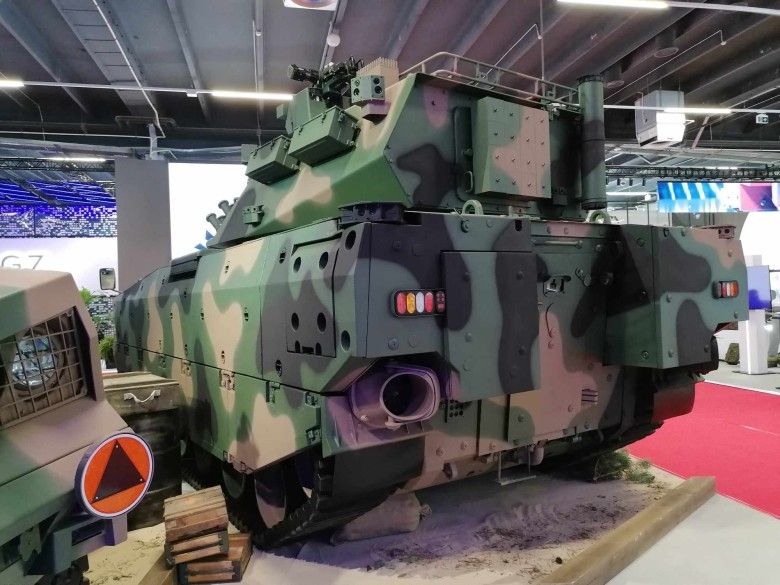MSPO 2024: Upgraded Rak mortar on the Borsuk IFV platform

Photo. Adam Świerkowski/Defence24
One of the key premieres at MSPO 2024 was the new variant of the M120 Rak self-propelled mortar. The upgraded turret system (referred to as M69 by HSW) was mounted on the BWP Borsuk chassis.
The M120K Rak self-propelled mortars have been integrated into the Polish Armed Forces, providing fire support for units equipped with the KTO Rosomak. Over time, a tracked variant had to be developed to operate in synergy with the new Borsuk infantry fighting vehicles. Ironically, the first test chassis for the turreted M120 system, meant for the Rosomak, was borrowed from the tracked 2S1 Goździk self-propelled howitzer.
Previously, HSW’s proposals for the tracked Rak (dubbed Rak-G) included mounting it on the Light Tracked Chassis (LPG) or its version with a hydropneumatic suspension. During this year’s MSPO, a variant identical to the Borsuk’s amphibious IFV chassis was presented.
The engineers at Huta Stalowa Wola (HSW) have not been idle, awaiting decisions regarding the final configuration of the tracked Rak. They have been continuously working not only on the carrier but also on the turret system. The result of these efforts, a new version of the mortar, was showcased earlier this year.
Read more
The changes are immediately visible to the naked eye. The turret geometry has been completely revised, now lower than its predecessor and featuring a more aggressive appearance. Additionally, a new 120 mm smoothbore mortar has been introduced, with a barrel length of 33 calibers (4 meters), compared to the previous 25 (3 meters). This modification has extended the firing range with standard ammunition from over 10 km to around 13 km.
Moreover, the autoloader system has been improved and simplified. The mortar now offers a higher rate of fire, estimated at 10-12 rounds per minute (previously 6-8), translating to shot intervals of only 5-6 seconds. During factory and state testing (if the military expresses interest in this project), performance may prove even better. The turret’s first-line ammunition magazine holds 20 mortar bombs ready to fire, with 40 more in the hull.
Guide to Technology and Capabilities
The 120 mm Self-Propelled Mortar Turret System (MSSW-120) can be mounted on any chassis with the required load capacity, such as the LPG, Borsuk, or Rosomak. Noteworthy, the previous version was also demonstrated on the chassis of the German Marder 1A3 infantry fighting vehicle, indicating significant export potential. According to industry rumors, several foreign clients have shown interest in the system.
The demonstrator presented at MSPO 2024 is a combination of the MSSW-120 turret system (designated M69 by HSW) and the Borsuk infantry fighting vehicle chassis. Not far from it, a Borsuk with the standard ZSSW-30 unmanned turret was also displayed. Rak, in this configuration, could (if desired by the customer) possess autonomous amphibious capability. The tracked Rak also features propellers for amphibious operations.
The turret is equipped with additional components. These include the SOD Atena 360-degree observation system from PCO (a similar solution was used on the Borsuk chassis, provided by WZE), the Obra-3 self-defense system, a launcher for the Polish-made Underant multirotor unmanned aerial vehicle, and a remotely controlled weapon module developed by ZM Tarnów. The new Rak also includes the well-known ZZKO Topaz system, Fonet internal communication, and the Honeywell TALIN 5000 inertial navigation system.
One notable feature is the Pangolin explosive reactive armor (ERA), with its modules placed on the rear doors of the turret. Discussions with HSW representatives revealed plans to integrate it both with the tracked Rak (Pangolin-RK variant) and the much larger Krab (Pangolin-KB). This solution significantly enhances vehicle protection against FPV drones and shaped charges, such as those used in anti-tank grenade launchers. The Pangolin ERA design is flexible enough to be adapted to various threats, making its use on the Rak highly beneficial (limited only by the potential requirement for buoyancy and chassis load capacity).

Photo. Adam Świerkowski/Defence24
Like the standard Borsuk, the vehicle is powered by an MTU 8V 199 TE20 diesel engine with 720 HP, paired with an Allison X300 transmission. Allison 3040MX is the target gearbox for the vehicle. The vehicle can reach speeds of up to 65 km/h. The ballistic protection level for the hull is rated at level 4 at the front and level 3 on the sides according to the STANAG 4569. The demonstrator, like several other Borsuk IFVs, has been fitted with CRT elastomer tracks from the Canadian company Soucy Defense, enhancing offroad mobility, ride comfort, and reducing vehicle weight by several hundred kilograms, improving amphibious capabilities.
HSW has successfully created a technology demonstrator with strong export potential. The MSSW-120 module on the Borsuk chassis will also offer high IED/mine protection levels. It remains to be seen whether both the Borsuk and its cousin with the 120 mm mortar will enter the Polish Army’s inventory in large numbers.




